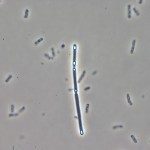Lien vers Pubmed [PMID] – 10601207
J. Bacteriol. 1999 Dec;181(24):7500-8
Little is known about the molecular mechanism by which histone-like nucleoid-structuring (H-NS) protein and cyclic AMP-catabolite activator protein (CAP) complex control bacterial motility. In the present paper, we show that crp and hns mutants are nonmotile due to a complete lack of flagellin accumulation. This results from a reduced expression in vivo of fliA and fliC, which encode the specific flagellar sigma factor and flagellin, respectively. Overexpression of the flhDC master operon restored, at least in part, motility in crp and hns mutant strains, suggesting that this operon is the main target for both regulators. Binding of H-NS and CAP to the regulatory region of the master operon was demonstrated by gel retardation experiments, and their DNA binding sites were identified by DNase I footprinting assays. In vitro transcription experiments showed that CAP activates flhDC expression while H-NS represses it. In agreement with this observation, the activity of a transcriptional fusion carrying the flhDC promoter was decreased in the crp strain and increased in the hns mutant. In contrast, the activity of a transcriptional fusion encompassing the entire flhDC regulatory region extending to the ATG translational start codon was strongly reduced in both hns and crp mutants. These results suggest that the region downstream of the +1 transcriptional start site plays a crucial role in the positive control by H-NS of flagellum biosynthesis in vivo. Finally, the lack of complementation of the nonmotile phenotype in a crp mutant by activation-deficient CAP mutated proteins and characterization of cfs, a mutation resulting in a CAP-independent motility behavior, demonstrate that CAP activates flhDC transcription by binding to its promoter and interacting with RNA polymerase.
